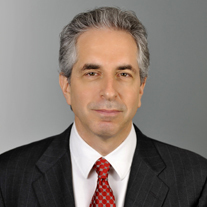An interview published in the New York Journal recently
Steve Wolosky, co-chair of activist and equity investment and corporate/securities law practices at Olshan Frome Wolosky, a midsize law firm in midtown Manhattan, told the New York Law Journal that the firm is big enough to handle large, complex transactions but small enough to be conscious of doing it cost-effectively. He sees that as the firm’s competitive advantage. Other law firm leaders participating in the series are Craig Wittlin of Harter Secrest & Emery, Richard Stehl of Otterbourg, David Scherl of Morrison Cohen, Robert Creighton of Farrell Fritz and Ronald Shechtman of Pryor Cashman.
Q: How big is your firm, where is it located and what are its primary areas of practice and focus? A: Olshan Frome Wolosky is a firm of 90 lawyers and 60 staff located in midtown Manhattan. Our core practice areas include corporate and securities, shareholder activism, real estate and litigation, along with other key areas, including intellectual property, tax, employment, employee benefits and ERISA, bankruptcy, and advertising, marketing and promotions. The firm’s primary focus is on representing entrepreneurial clients in sophisticated business transactions.
Q: Please explain your firm’s governance structure and compensation model. A: The firm has a group of committees including an executive committee and a compensation committee. Just about half of our partners have a role on one or more of our principal committees. But, as a practical matter, I cannot even recall the last time that we had a formal committee vote on anything, as our size benefits us in typically acting by consensus. We have two co-administrative partners who handle both day-to-day firm operational matters and long-term strategic planning. Our compensation model is not formulaic but takes into account the typical factors, including profitability of practice areas, business growth, partner contributions to client matters and contributions to firm goals such as associate development, succession planning and risk management.
Q: What do you view as the two biggest opportunities for your firm, and what are the two biggest threats? A: Olshan’s two greatest opportunities play to the firm’s greatest strengths: Increasing share of market due to a “right size” firm model and capturing client markets in several niche/specialized practice areas in which few firms practice. As a “right size firm”—big enough to handle large, complex transactions, but small enough to be conscious of doing it efficiently and cost-effectively—Olshan lawyers really know their clients and their needs, something that large firm “client service teams” have been trying to figure out for years. The firm’s lean leveraged staffing model is reflective of its roll-up-your-sleeves philosophy, and our relatively small size among midsize firms has proven to be a competitive advantage, as it lends itself to a more collaborative environment across all levels of lawyers. For this reason, many of Olshan’s clients have been with the firm for many years, and we have been able to attract additional new clients given the economies of the legal service market since the recession. Our biggest source of business has and continues to be referrals by existing clients who appreciate the valued services Olshan provides. The firm has stayed ahead of the competition in representing clients in niche practice areas like advertising, marketing and promotions, where lawyers represent a cache of trendsetting clients, and the marquee shareholder activist practice, which has kept shareholder activism on the front pages of the financial press. Conversely, Olshan’s two biggest threats are controlling non-personnel costs and continuing to attract talented associates and partners in a competitive legal market. Like all businesses over the past few years, Olshan has had to take a good, hard look at cost efficiencies across the board, most particularly in areas including office space. When the firm’s lease came up for renewal in 2015, we saw it as an opportunity to address a long-term economic challenge and plan efficiently for measured growth. Moving to a newly designed office in a more central midtown location has enabled the firm to expand substantially beyond its existing head count through the life of its new lease by maximizing square footage utilization as compared to its old space, without incurring additional space acquisition costs. To improve client matter efficiencies and profitably manage client matters, Olshan has been focused on reducing the overall cost of its low leverage model while continuing to provide high quality. We have been very successful to date in attracting talented lawyers to our firm—but not a day goes by when we don’t strategize to make sure the advantages of the way we practice is communicated to candidates. Over the past several years we have recruited lateral partners and counsel from firms, including Morgan, Lewis & Bockius and Greenberg Traurig, and associates from a range of firms, including Wachtell Lipton [Rosen & Katz], DLA Piper, and Orrick, Herrington & Sutcliffe.
Q: After the recession hit, the prevailing theory was that midsize firms would start to see more work come their way from large clients who could no longer justify paying Big Law rates. What has been your experience? A: The movement of clients and their business from Big Law to Olshan started happening well before the recession, and the pace certainly picked up in some areas of practice following the recession. Since its founding, Olshan has offered an alternative to the Am Law 50 law firm business model with responsive, independent and client-focused legal counsel provided by the firm’s lawyers.
Q: Are your clients pushing for more alternative fee arrangements, and if so what types? Is your firm amenable to those requests? A: Olshan is able to offer clients the best of both worlds—competitive pricing at midsize firm rates and matters staffed by experienced partners, by continuing to be innovators in matter management and creative billing arrangements. Some of the ways that the firm keeps client matter costs in check while maintaining profitability include:
- Working with clients to budget major legal projects including negotiated trim budgets for significant corporate and real estate transactions where we know the client, evaluated the proposed transactions and clearly defined Olshan’s role and staffing. Tasking specific projects at fixed, agreed costs where it makes sense.
- Taking on partial contingency cases where we agree to significantly reduce hourly rates in exchange for a percentage of the recovery.
- Encouraging entrepreneurship with younger lawyers by offering their startup or smaller clients structured, reduced rates.
Q: There is much debate around how law firms can foster the next generation of legal talent. What advantages and disadvantages do midsize firms have in attracting and retaining young lawyers, particularly millennials? A: In a market where lawyers are being promoted in decreasing numbers at both large and midsize firms, Olshan has promoted 11 lawyers to partner and counsel positions over the past several years. That’s over 10 percent of Olshan’s partner/counsel ranks, so not insignificant to a firm our size. The areas of promotion are all key practices and areas of sustained growth. Over the past several years Olshan has also promoted two partners under the age of 40 (at the time of appointment) to lead key practice areas, emphasizing to young lawyers that Olshan takes this issue seriously. We also encourage associates to develop business and compensate them for their efforts as we believe that encouraging young attorneys to develop their own clients strengthens their skills.
Q: Does your firm employ any nonlawyer professionals in high-level positions (e.g., COO, business development officer, chief strategy officer, etc.)? If so, why is it advantageous to have a nonlawyer in that role? If not, have you considered hiring any? A: We have been very fortunate to have several high-level managers who act as trusted and influential advisers and who have successfully led our staff and office operations for many years. Given our size, our firm culture and consistency of operations, this model serves the firm and our clients’ needs much more effectively than an MBA-driven corporate structure.
Q: What, if any, technology advancements have you made in your firm in recent years? What are the challenges in implementing tech changes? A: Mobility has been our No. 1 goal—our lawyers can be effective working from court, a client’s office or while waiting for their child’s school play to start. We have also continued to invest in one of the firm’s top priorities—improving back-up technology and anti-hacking protections ongoing to remain state-of-the-art in this significant area.
Q: What would you say is the most innovative thing your firm has done recently, whether it be internal operations, how you work with clients, etc.? A: When we moved to a new office recently we created a space that reflected our brand identity and work style, spread over two connecting floors in a productively designed work area. Previously, the firm had been spread over three floors, separated by labyrinths of hallways and stairwells, which made it more difficult to gather a team and collaborate. Our new space is reflective of our spirit of creativity and collaboration, and also highlights our commitment to our expanding client base in key areas. Many of the firm’s newer clients are the next wave of brand builders, emerging companies and technology innovators, and bringing them to a space that mirrored their culture was important. Olshan’s design is trend-setting in the legal industry, with “one size fits all” lawyer offices that break down spatial and hierarchal boundaries, creating a more collaborative environment. In addition, the firm is bucking the law firm downsizing trend in planning for the future, allowing for additional growth. As Olshan’s attorneys work closely with each other and in teams to find solutions for clients, having a space that reflects those needs will enhance the firm’s productivity and synergy.
Q: Does your firm have a succession plan in place? If so, what challenges do you face in trying to execute that plan? If you don’t currently have a plan, is it an issue your firm is thinking about? A: Succession planning, both in terms of firm management and practice leadership succession, is a daily focus. In fact, we are in the process of transitioning the firm from the second to the third generation which is reflective of our long-term viability as a midsize business-oriented firm. Our strategy over the years has been to grow and develop leadership talent within the firm, which has proven successful. Over the past two years alone, we have handed the practice leadership reins to organically developed talent in two key practice areas—shareholder activist and equity investment and litigation. Rather than have a single head of the firm, the firm has used a shared firm management platform for a number of years which assures that succession issues will be smoothly transitioned.
For more information contact:
Andy Lustigman
Olshan Frome Wolosky
alustigman@olshanlaw.com
+1 212 451 2258
www.olshanlaw.com


